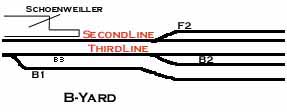Basic Operating Description.........
As I have stated elsewhere in this website, the JLS Railroad operates as close to prototypical as possible. We have well defined industries and businesses along the lines that need regular deliveries and shipments. These industries and businesses range from the farm to the engine shops to the Stations. Now, on the JLS Railroad, the train station doesn't just represent a single station, rather it represents an entire village (we couldn't model the entire village due to size constraints). This means that it gets deliveries for the outlying small businesses as well.
Each engine has it's own log. We keep tract of the engines fuel quantity, sand quantity and coal and water if it is a steam engine. Every 50 hours of use, the engine goes into the shop where it gets lubricated and cleaned. We take VERY good care of everything, every piece of rolling stock and every engine. That is why we have NEVER had any engine damage due to ware or misuse or rolling stock damaged in any way. Click here for Rolling Stock roster, or here for the Motive Power roster.
A normal operating session begins with a review of the schedule. We run two ways, a timed run and a free run. Both ways, we have a well defined schedule with deliveries and pickup all listed. Since we are 6 lines (including the H-yard, E-yard and Trolley Line which are all independently controlled), we have a page on the schedule for each line. Now, a free run's schedule is just a task list. It has all important notes and train movements on it. A timed run is just that, a schedule that is timed. It is still in list form, but, now with times that each delivery must be completed by. It is a much more stressful run, always looking at the clock and worrying about completing on time or not. It is also MUCH more difficult to make, taking upwards of an hour to create one. The main reason for this is because we not only have to assign times to one line's list of movements, but, all 6 independently controlled sections of trackage. The difficult part is making sure all the lines times work with each other. If a cut of cars is to be moved from the ThirdLine to the MainLine, the times on both schedules must coincide. Due to the difficulty of creating that type of schedule, 90% of the times, we run with a free run schedule. TrainShows utilize a variant of the timed schedule. Here, we have a basic timed schedule but with train descriptions, reasons for movements and location of movements next to the item on the list. The reason for this is because a copy of the schedule is given to every guest so he can follow along to see not only what is happening, but also why and where it is happening.
A basic operating session begins with power up of the layout, obviously. That task takes about 5 minutes. We have a total of 8 Control Master 20 transformers and 3 TrainPower 6200s, all from MRC. Aside from that, all blocks must be activated, all industries turned on, layout lighting powered up, signal system takes 1 minute and 30 seconds for the computer chips to clear and power up and make sure all the track is clear and switches set. Then we have a review at the schedule at hand. The days trains are created and the last runs trains are broken down. That task usually takes about 2 hours in the 6 hour run period. We then start deliveries, set outs and pick ups. That task lasts the remainder of the standard 6 hour run. Aside from just feeding the industry, we have to keep the yards clean, work trains must go out, engines and cars brought to the roundhouse, backshops and car shops. Engines and steamers must be fueled and sanded. We also have to worry about train classes. The following is the class list from most important to least important:
Now as I stated earlier, the layout has reached the point where it can no longer be run by one person, you need two or even three for a comfortable run. If we have two people, which is most likely to be the case for most runs during the week, one person is on the MainLine, SecondLine and ThirdLine and the other person is on the new H-yard (Helix). This is very stressful. The H-yard is so large and complex, it needs a full time operator to keep things flowing smoothly. Before the H-yard, one person took the MainLine, and the other the other 2 lines. That made for a nice, easy run. Now, a third person is almost necessary. The ideal operating scenario would be one person on the MainLine, one person on both the SecondLine and ThirdLine and a third person for the H-yard. At this point, the only time that happens is during the meets, Thursday nights. During meets, the active members and semi-active members get together (see Member Directory for member information, or Club Information for membership information). This works out really well, although the control circle is a little cramped. We have a person on each line (Main, Second and Third) plus a person to operate the H-yard. That makes 4 people running. If more members show, we have jobs such as schedule controller (a person to review the schedule and direct traffic, like a yard control man), as well as a yardman. The yardman is the most helpful and useful person, although that job is the most hated job. Since we can't possibly put an autouncoupler on every section of track, during switching operations, it is the yardman's job to track a train and uncouple the needed cars or load and unload cargo (due to G-scale's size, if we have crates to deliver to a freight shed in a boxcar, there are actually crates in the boxcar! That means the doors of the boxcar must be opened and the crates pulled out.) These large turnout runs don't occur frequently, unfortunately. That is mainly because real life gets in the way of train life! haha
The JLS Railroad has 3 main yards, all connected to the MainLine. They are the W-yard, E-yard and the H-yard (Helix). Mainly, they are used for massive storage, of staging of cuts of cars. The W-yard is a one sided ladder which is fairly small. It has a small 2 stall engine shed which we use for switcher storage or the track cleaner. The W-yard is about 8 feet long with 7 sidings including the engine shed and is mainly used for single car storage and excess car storage.
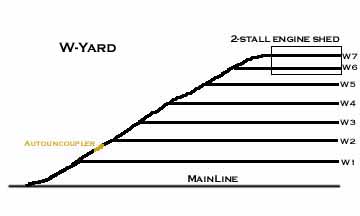
The E-yard is about 20 feet long and is the main yard for keeping cuts of cars and hole trains. It has it's own fueling facility and switcher siding. It is comprised of 7 sidings. We use this yard for the storage of entire trains mostly. If there is a break in the schedule and a train needs to be off the Main for some reason or another, it goes here for temporary storage in E1. Long term storage for completed trains takes place in E2-E6. E7 is the refueling point / switcher storage siding.
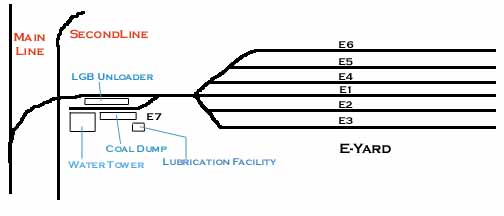
The H-yard is BIG there are no two ways around that. It is about 10 feet wide by 19 feet long. It has a 10 stall roundhouse with turntable, a 2 stall engine shed, a reverse loop, a wreck siding, a wheel track, 12 siding staging yard, saw mill complex with 2 sidings for loading and unloading, a tank farm, refinery, full backshop, sanding depot, ash pit, coaling tower, water crane and pump house for the vacuum brakes on the cars (keep them energized). It is big. All engine turnarounds happen here. Cars and entire trains can be staged here. There are major industries locate in the yard as well. It has it's own control panel and block system. It is comprised of 2 3-way switches and 18 switches as well as about 30 blocks. Many trains are started here and moved down the 110 foot long helix to get to floor level. The helix leading up to this yard (on a table 39" from the floor where the rest of the layout is located) is of variable grade from .4% to 4.4%. It is made of wood with 4" high plexiglass "guard rails" along the entire length of it on both sides to prevent a $1000 piece of equipment from tumbling to the floor if there is ever a derailment on the helix. Now, due to the sheer weight and power of LGB engines, I can pull 10 to 12 cars up that grade with a large engine or 5 to 7 with a smaller engine. The really small switchers are good for 5 cars. I have installed 120 feet of rack up the helix and into the yard. I have 2 cog locomotives now, LGB's small Ge 2/2 electric rack loco, and the Brunig Rack Steam Locomotive. With the rack locomotives, you can EASILY pull a consist of 20+ cars up the grade with no problem. We did a one time test of the power of that single rack loco, he pulled 43 cars up with NO PROBLEM. We don't do that though because I am fearful of causing internal problems with the motor, it was a one time test which you must be amazed at the results!
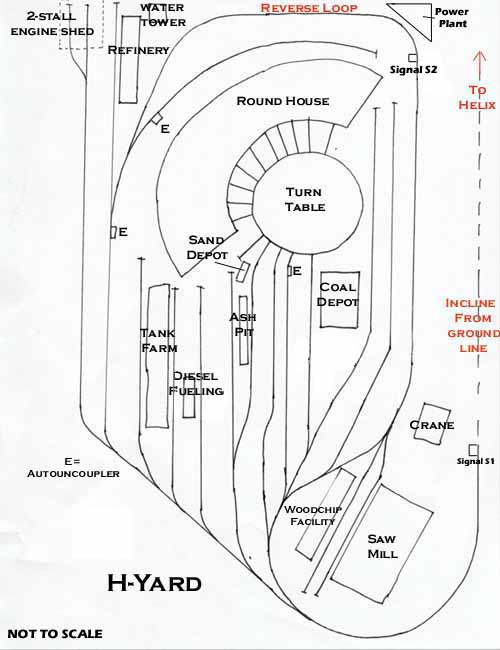
As more equipment was purchased for use on the JLS Railroad, more storage space was needed in terms of sidings. Out of this necessity grew the Hanging Yard, technically called the M-Yard. The yard is actually suspended from the bottom of the H-Yard hanging about 240mm off the floor (over the E-Yard below). The yard is accessible only via the Helix making operations interesting and enjoyable. The yard itself is roughly 4 feet wide by 12 feet long. It consists of 7 sidings comprised of 8 blocks. Although nowhere near as large as the H-Yard, the Hanging Yard allows for quite a few pieces of rolling stock and locomotives to be stored.
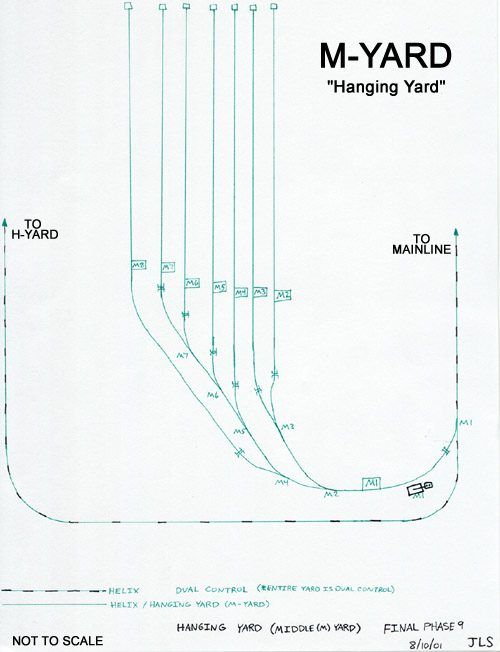
The MainLine also has a smaller yard called the P-yard, it is used entirely from small train lay up or for large train storage. It has 3 sidings, a 28 foot siding for train storage, a 5 foot siding with a sanding depot and a 8 foot block (lead to the other two sidings) for train lay up. Aside from these main yards, there are about 8 other sidings and industries including the 34 foot farm siding.
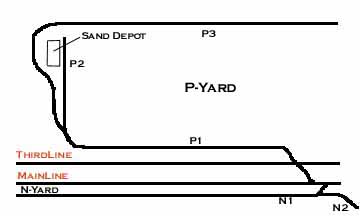
The SecondLine is the smallest of the lines (with the exception of the Trolley Line) and is considered a branch line. It is about 35 feet long by 10 feet wide. It has 5 sidings, all labeled with the designator F, thus the F-sidings. F1 is a small 4 foot long wreck siding and refuse dump. F2 is a block in front of the station Schoenweiller (the largest town on the layout) an is about 30 feet long. F3, F4 and F5 are all in the only yard on the SecondLine. F3 is the lead, F4 and F5 are the sidings, about 15 feet long. They are basically used for SecondLine train storage, where the trains tend to run shorter then on the MainLine due to the much sharped curves.
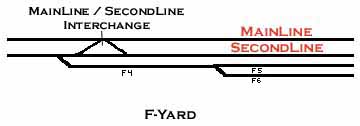
The third line is fairly large, about 22 feet across by 35 feet long. It has only 2 sidings though, located right next to each other. B1 (B is the designator for the ThirdLine) is a long 28 foot long siding in front of Schoenweiller. B2 is a short 7 foot siding used for a work train or small cut of cars making deliveries to Schoenweiller.
